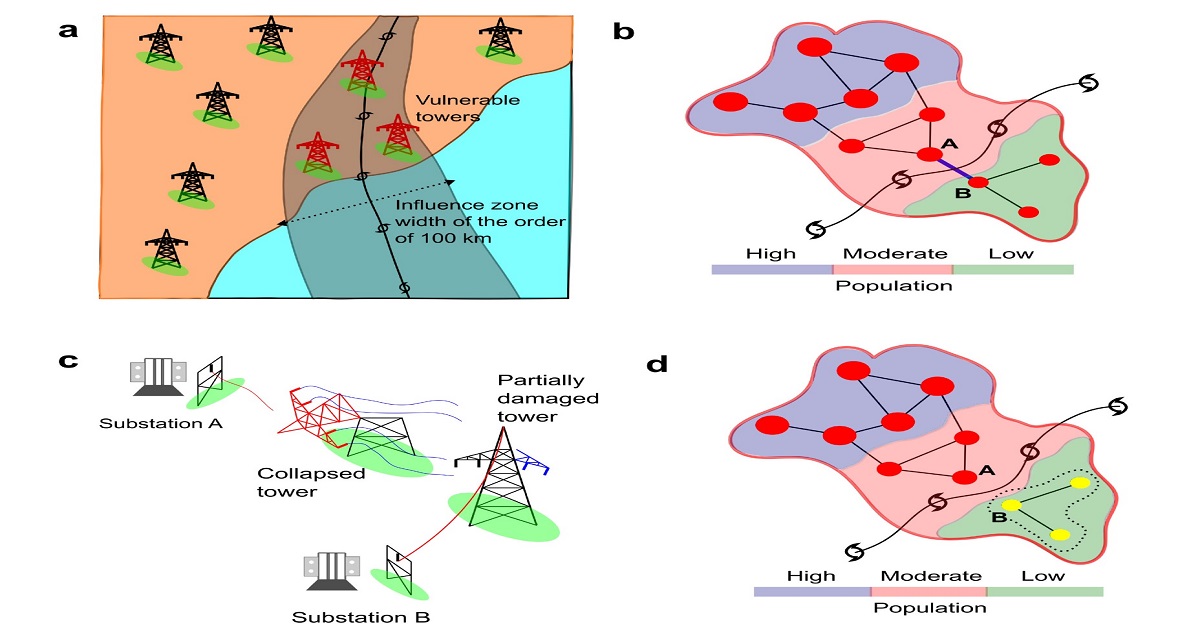STORY CREDITS
Writer/Editor: Shivangi Vasudev Bhatt
Photo: Media and Communication, IIT Gandhinagar
The damage to the power transmission and distribution systems due to the increased frequency and intensity of cyclones triggered by climate change and their consequent impact at various levels is a major cause of concern for coastal regions of India. Odisha, one of the most cyclone-prone states in the eastern part of the country, has suffered economic losses and critical infrastructure damages worth thousands of crores in the past few years because of recurrent and severe cyclones. In such scenarios in coastal regions, power supply is the most significant infrastructure because it directly affects the functioning of other essential infrastructural systems such as communication, water supply, wastewater systems, transportation, and so on. Therefore, it is desirable to strengthen the power transmission and distribution systems in such a way that they incur very less damage to minimise the overall loss of functionality under future cyclones.
Taking cognisance of this evolving grave scenario, a team of researchers at the Indian Institute of Technology Gandhinagar (IITGN), comprising Surender V Raj (MTech Student), Prof Udit Bhatia, and Prof Manish Kumar, studied Odisha’s power transmission network damaged during Cyclone Fani in 2019, with a focus on the vulnerability of individual towers to strong winds generated during cyclones, and developed a comprehensive framework that can help curtail overall losses in functionality to a substantial extent. Their integrated approach opens up fresh possibilities for actionable engineering and strategic policy interventions in any vulnerable coastal regions of the country. The findings of this work have been recently published in the International Journal of Disaster Risk Reduction by Elsevier: https://www.sciencedirect.com/science/article/abs/pii/S2212420922001765.
How the analysis for developing the framework was done:
Based on the data collected from the Odisha Power Transmission Corporation Limited (OPTCL) about damaged transmission towers due to Cyclone Fani and the estimated maximum cyclonic wind speeds at the locations of these towers using a radial wind profile model, the team assessed the damage probabilities for more than 41 thousand power transmission towers. Subsequently, a series of simulated realistic cyclone scenarios were generated to study the functionality of the transmission system and estimate the population that can get affected due to a range of cyclone scenarios.
The research team observed that the loss in functionality of transmission towers depends considerably on the location of the landfall of the cyclone. The damage was greater if the landfall was close to a region with many substations in the vicinity. This observation emphasises the need to consider the orientation of the network with respect to the coastline and the realistic properties of the cyclones. Researchers also noted that the loss of functionality in power transmission could be affected considerably by the path of a cyclone before making landfall. A simulated cyclone trajectory indicated that it could damage towers even up to 300 km apart from each other, which further underscores the need to perform such studies on a holistic scale.
What is the framework, and why is it important for coastal regions?
Damage to power transmission lines at a larger scale leads to a significant and sudden loss of connectivity, consequently increasing the magnitude and duration of disruption in the aftermath of the cyclone, which can sometimes hinder the rescue operations as well.
The framework developed by the team helps in prioritising the towers that should be strengthened to minimise the overall losses in functionality in a cost-effective manner. They use damage-cum-wind speed data to develop a fragility model for towers, which helps assess the functionality of the network and the influence of strategic interventions on the same. The team considered two broad aspects to identify the towers for priority strengthening: 1) Identification of a geographical region and 2) Basis for prioritisation within that geographical region. Each intervention suggested by the team is unique from each other in terms of selection of a geographical region, the basis for prioritising the towers, the number of towers to strengthen, and the extent of strengthening considered.
The team found that the most efficient strategy could be to pick a fraction of towers from the highest wind speed zones (according to the Indian standards) that are associated with substations serving a large population. On the other hand, strengthening towers nearest to the coast may somewhat help reduce the number of towers damaged during a cyclone, but its resultant impact on the affected population may not be as significant.
Expectedly, the study results revealed that a greater number of reinforced towers or a greater level of strengthening in them based on the tailor-made and efficient reinforcement prioritisation strategies in a particular region leads to better functionality of power transmission systems. The research team also found that strengthening the towers in a transmission line associated with important substations (importance was quantified in terms of population served by the substation) close to the coastline led to maximum enhancement in performance, meaning the lesser population is affected.
Explaining the significance of this framework further, Prof Manish Kumar, Associate Professor of Civil Engineering at IITGN, said, “This is a first of its kind research work because here we were able to consider a large-scale network, its relationship with the coastline, a suitable context-specific fragility curve for the towers, and realistic cyclone scenarios in a reasonable manner, which led to interesting insights into strengthening strategies for the power transmission network of Odisha. The framework can be useful for cost-effective strengthening of the transmission tower networks of other coastal states of India as well, such as West Bengal, Andhra Pradesh, Tamilnadu, Gujarat, and Maharashtra. The towers can be prioritised differently if a different performance metric is selected. Structural strengthening that would lead to the shift in the fragility curves considered in this study can be based on wind-tunnel tests and/or computational fluid dynamics analyses, which will further optimise the resources. This approach may also be relevant for transmission lines associated with some power plants that may require a shutdown in the event of damage to the lines.”


Discussing the need to have ready-made plans for recovery after catastrophic events, Prof Udit Bhatia, Assistant Professor of Civil Engineering at IITGN, said, “In post-disaster scenarios, the decision-makers always face a constraint on 3Ms, i.e. Manpower, Money (budget), and Materials. Hence, there is a need to supplement the bird-eye view with the component level view to identify the right set of components that should be reinforced and strengthened to minimise the damages after natural calamities. The changing climate scenarios and upward trend in frequency and magnitudes of cyclones as a consequence of increasing Sea Surface Temperature put our coastal infrastructure at a greater risk. While our understanding of these hazards has increased significantly in recent years, still a lot needs to be done on the adaptation side. In our related patented work, we showed that strategic interventions could result in 2.3 times faster restoration of services in the networked systems, helping businesses and lives come back to normalcy in a swift manner. Our framework brings us one step closer to possible solutions that stakeholders and infrastructure managers can invest in.”
This news has been covered by some of the leading Indian newspapers and media agencies. Click on the links below to read more.

